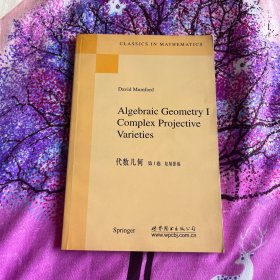
傅立叶级数(第1卷第2版),两本合售,没有划痕,Fourier analysis
¥ 380 九五品
仅1件
陕西西安
认证卖家担保交易快速发货售后保障
作者R.E.Edwards 著
出版社世界图书出版公司
出版时间2003-11
版次1
装帧平装
上书时间2024-08-18
- 最新上架
商品详情
- 品相描述:九五品
图书标准信息
- 作者 R.E.Edwards 著
- 出版社 世界图书出版公司
- 出版时间 2003-11
- 版次 1
- ISBN 9787506265782
- 定价 36.00元
- 装帧 平装
- 开本 其他
- 纸张 胶版纸
- 页数 224页
- 【内容简介】
- The principal aim in writing this book has been to provide an introduction, barely more, to some aspects of Fourier series and related topics in which a liberal use is made of modern techniques and which guides the reader toward some of the problems of current interest in harmonic analysis generally. The use of modern concepts and techniques is, in fact, as wide-spread as is deemed to be compatible with the desire that the book shall be useful to senior undergraduates and beginning graduate students, for whom it may perhaps serve as preparation for Rudin's Harmonic Analysis on Groups and the promised second volume of Hewitt and Ross's Abstract Harmonic Analysis.
- 【目录】
-
Chapter 1 TRIGONOMETRIC SERIES
AND FOURIER SERIES
1.1 The Genesis of Trigonometric Series and Fourier Series
1.2 Pointwise Representation of Functions by Trigonometric Series
1.3 New Ideas about Representation
Exercises
Chapter 2 GROUP STRUCTURE
AND FOURIER SERIES
2.1 Periodic Functions
2.2 Translates of Functions. Characters and Exponentials. The Invariant Integral
2.3 Fourier Coefficients and Their Elementary Properties
2.4 The Uniqueness Theorem and the Density of Trigonometric Polynomials
2.5 Remarks on the Dual Problems
Exercises
Chapter 3 CONVOLUTIONS OF FUNCTIONS
3.1 Definition and First Properties of Convolution
3.2 Approximate Identities for Convolution
3.3 The Group Algebra Concept
3.4 The Dual Concepts
Exercises
Chapter 4 HOMOMORPHISMS OF CONVOLUTION
ALGEBRAS
4.1 Complex Homomorphisms and Fourier Coefficients
4.2 Homomorphisms of the Group Algebra
Exercises
Chapter 5 THE DIRICHLET AND FEJER KERNELS.
CESARO SUMMABILITY
5.1 The Dirichlet and Fejer Kernels
5.2 The Localization Principle
5.3 Remarks concerning Summability
Exercises
Chapter 6 CESARO SUMMABILITY OF FOURIER SERIES
AND ITS CONSEQUENCES
6.1 Uniform and Mean Summability
6.2 Applications and Corollaries of 6.1.1
6.3 More about Pointwise Summability
6.4 Pointwise Summability Almost Everywhere
6.5 Approximation by Trigonometric Polynomials
6.6 General Comments on Summability of Fourier Series
6.7 Remarks on the Dual Aspects
Exercises
Chapter 7 SOME SPECIAL SERIES AND THEIR
APPLICATIONS
7.1 Some Preliminaries
7.2 Pointwise Convergence of the Series C and S
7.3 The Series C and S as Fourier Series
7.4 Application to A Z
7.5 Application to Factorization Problems
Exercises
Chapter 8 FOURIER SERIES IN L2
8.1 A Minimal Property
8.2 Mean Convergence of Fourier Series in L2. Parseval''s Formula
8.3 The Riesz-Fischer Theorem
8.4 Factorization Problems Again
8.5 More about Mean Moduli of Continuity
8.6 Concerning Subsequences of SNf
8.7 A Z Once Again
Exercises
Chapter 9 POSITIVE DEFINITE FUNCTIONS
AND BOCHNER''S THEOREM
9.1 Mise-en-Scene
9.2 Toward the Bochner Theorem
9.3 An Alternative Proof of the Parseval Formula
9.4 Other Versions of the Bochner Theorem
Exercises
Chapter 10 POINTWISE CONVERGENCE
OF FOURIER SERIES
10.1 Functions of Bounded Variation and Jordan''s Test
10.2 Remarks on Other Criteria for Convergence; Dini''s Test
10.3 The Divergence of Fourier Series
10.4 The Order of Magnitude of sNf. Pointwise Convergence Almost Everywhere
10.5 More about the Parseval Formula
10.6 Functions with Absolutely Convergent Fourier Series
Exercises
Appendix A METRIC SPACES AND BAIRE''S THEOREM
A.1 Some Definitions
A.2 Baire''s Category Theorem
A.3 Corollary
A.4 Lower Semicontinuous Functions
A.5 A Lemma
Appendix B CONCERNING TOPOLOGICAL LINEAR SPACES
B.1 Preliminary Definitions
B.2 Uniform Boundedness Principles
B.3 Open Mapping and Closed Graph Theorems
B.4 The Weak Compaeity Principle
B.5 The Hahn-Banach Theorem
Appendix C THE DUAL OF Lp 1≤ p < ; WEAK SEQUENTIAL COMPLETENESS OF L1
C.1 The Dual ofLp 1 ≤p
点击展开
点击收起
相关推荐
— 没有更多了 —




























以下为对购买帮助不大的评价